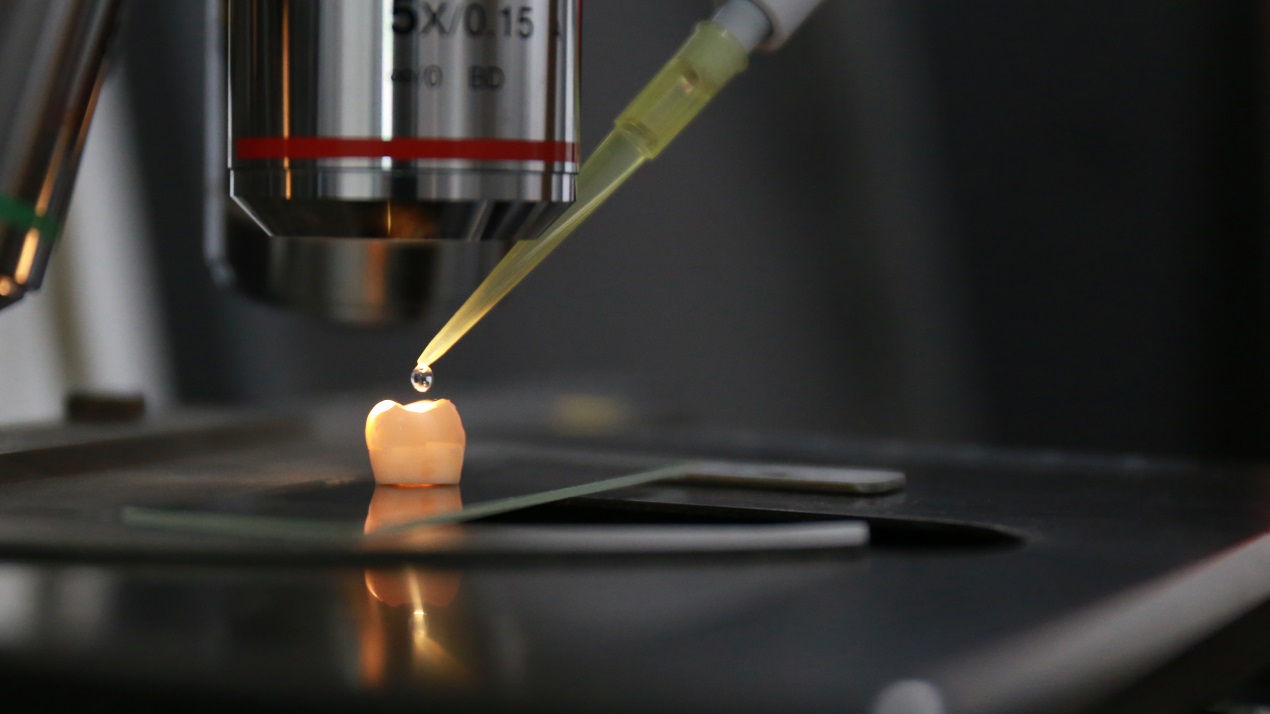Enamel is the biological tissue highly mineralized and almost an inorganic compound. Enamel is slightly less hard than diamonds and as hard as crystal. It is the hardest nature biological material in human bodies. Enamel can’t regenerate. After permanent teeth become mature, enamel will be depleted due to multiple causes. The acid that is produced during the breakdown of carbohydrate in food by bacteria and acid beverage that people drink will accelerate the depletion of enamel. The depletion of enamel usually means the loss of protection for human teeth. And it’s easier for human to get tooth decay if their enamel is depleted.

Tooth Anatomy
Enamel reparation is one of the biggest challenges in biomimetic field, scientists have never stopped research in this field. Filling materials including composite resin, ceramics and amalgam can fill “big holes” in teeth but not “cracks”. These materials can’t fully integrate with human tissues. Therefore, dentists always tell people who have just filled their teeth not to risk eating crabs and nuts. Some scientists also tried biomimetic mineralization, but due to the complicated structure of enamel, scientists are not able to produce the repairing layer with similar structure as enamel and reaches clinical requirements.
However, Prof. Tang Ruikang from the Department of Chemistry of ZJU will experience teeth reparation using biomimetic repair solution invented by his research team. And the reparation layer is almost the same as enamel in terms of composition, microstructure and mechanical property, and can integrate with surrounding tissue very well, which is almost the ideal reparation solution.
Here is how Prof. Tang’s team does experiments. They drop the solution rich in calcium phosphate clusters onto the surface of artificial decay tooth and leave it in the solution similar to saliva. After 48 hours, enamel appears on the surface of the tooth. And the biomimetic mineralization front appears at the beginning can fully integrate with the original enamel and facilitate the growth of the crystal. Another 48 hours pass, the “growing” crystal turns into the material that is the same as the original tissue and fully integrate with it.

Reparation Experiment
Clinical doctors regard this invention as a lab production closest to the requirements of clinical application so far. They use the material the same as human material and realize the complete repair in terms of structure. When Prof. Tang first see the SEM photos of the first reparation done by Hao Changyu and Liu Zhaoming, doctoral students from Prof. Tang ‘s research team, he suspected that the reparation layer had dropped and the reparation didn’t succeed. Therefore, Shao Changyu uses fluorescence indicator to create control groups on the single tooth. Although artificial repair can’t be observed on SEM photos, the fluorescence indicator tells the exact spot of reparation.

SEM Photo of Tooth. The dark part on the left isn’t repaired, the colored part on the right has been repaired. And the illustrations on the top are the SEM photos of enamel before and after reparation.
The research team also used Nano-indentation to test the mechanical strength of reparation layer. And the test showed that the hardness and elasticity modulus of the reparation layer is almost the same as enamel.
Prof. Helmut Cölfen, a prestigious biomineralization scientist from University of Konstanz said that this is the best enamel reparation material he had ever known and is most likely to realize in-situ reparation clinically. However, to achieve this goal, the technology will still go through strict animal experiments and clinical verifications. And there are multiple types of defects, so more repair models are needed.
The research result was published online on Science Advances. Shao Changyu is the first author and Liu Zhaoming is the co-corresponding author. The research has been supported by National Key Research and Development Project, Nature Science Foundation of China and China Postdoctoral Science Foundation.
(From ZJU NEWSROOM)

